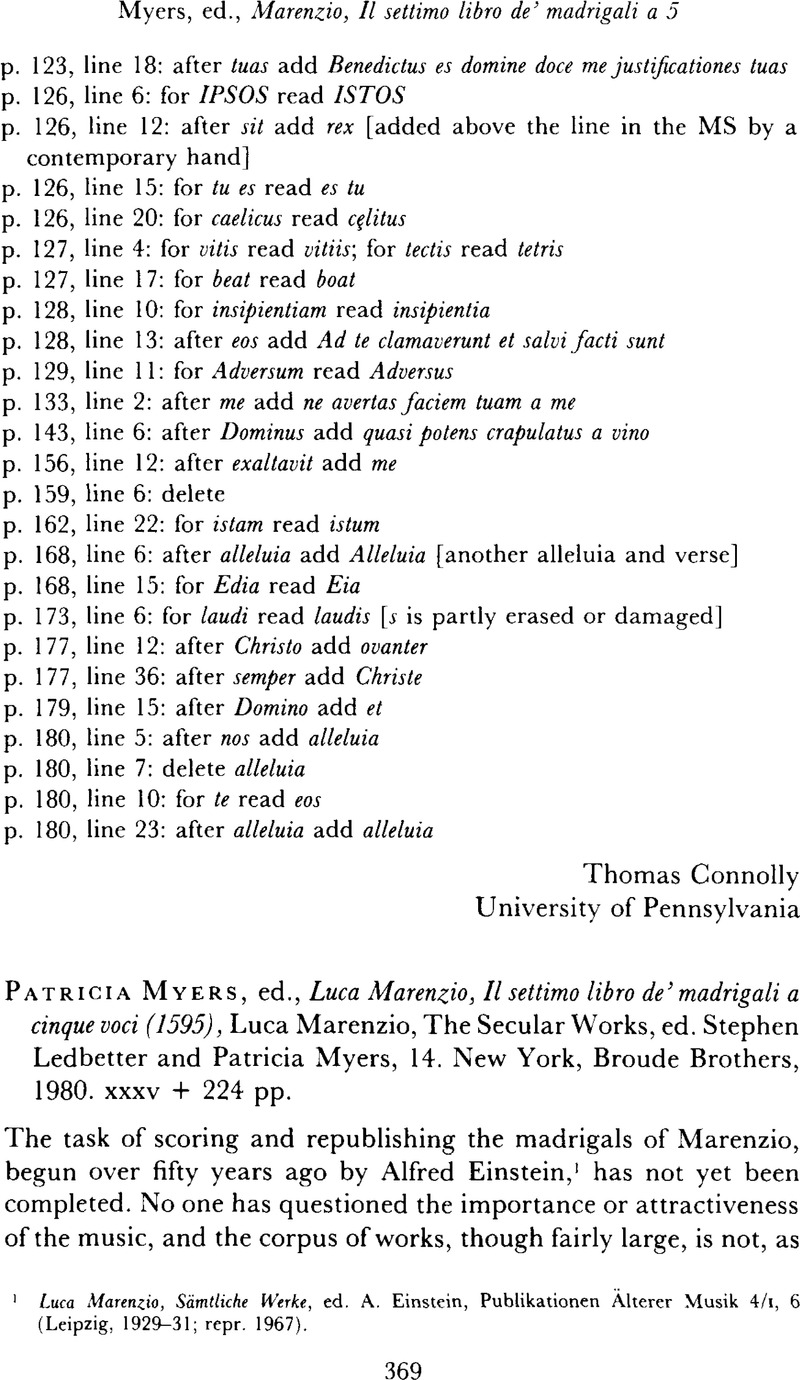Published online by Cambridge University Press: 05 December 2008

1 Luca Marenzio, Sämtliche Werke, ed. Einstein, A., Publikationen Älterer Musik 4/i, 6 (Leipzig, 1929–1931; repr. 1967)Google Scholar.
2 Luca Marenzio, Sämtliche Werke, Publikationen Älterer Musik 4/i, p. vii: ‘Der Revisionsbericht der Madrigale Marenzios gestaltet sich sehr einfach.’
3 First and Second Books of Madrigals, ed. Jackson, R., Marenzio, Luca, Omnia, Opera, ed. B. Meier and R. Jackson, 4 (n.p., American Institute of Musicology, 1978)Google Scholar; Madrigali a quattro, cinque el sei voci, libra primo (1588), Marenzio, Luca, The Secular Works 7, ed. Ledbetter, S. (New York, Broude Brothers, 1977)Google Scholar; Il settimo libra de madrigali a cinque voci, Le Opere Complete di Luca Marenzio 7, ed. Steele, John (New York, Les Editions Renaissantes, 1975)Google Scholar. For Einstein's edition see above, note 1. A valuable recent study of Marenzio's textual sources i s Chater, J., ‘Fond poetiche per i madrigali de Luca Marenzio’, Rivista Italiana di Musicologia, 13 (1978), pp. 60–103Google Scholar.
4 Marenzio's sacred music is being brought out, edited by Roland Jackson, in the American Institute of Musicology series Luca Marenzio, Opera Omnia; no duplication is planned here. Professor Steele has informed me in a recent letter that he does not expect his series to be continued.
5 In fairness I should say that the price of the volume under review is (or was, in November 1980) 128.00 to subscribers and $35.00 for the individual volume — not unreasonably high.
6 See Fenlon, I., Music and Patronage in Sixteenth-Century Mantua, I (Cambridge, 1981), p. 152Google Scholar. The closing piece of Marenzio's volume, Ombrose e care sehe, is the only one written in the kind of ‘public’, festive style used by Marenzio for his contributions to the Florentine intermedi of 1589.
7 On the very long concerts given by the musicians of Alfonso's musica secreta see Newcomb, A., The Madrigal at Ferrara, 1579–1597, i (Princeton, 1980), pp. 25–6Google Scholar.
8 See Powers, H. S., ‘Tonal Types and Modal Categories in Renaissance Polyphony’, Journal of the American Musicological Society, 34 (1981), pp. 428–70CrossRefGoogle Scholar; Powers, ‘Modal Representation in Polyphonic Offertories’, pp. 43–86 above.
9 Einstein, A., The Italian Madrigal (Princeton, 1949), n, p. 678Google Scholar.
10 No. 1, bars 40–1: Bbs in the cantus; no. 3, bar 49: Bb in the bass; no. 14, bar 26: Eb in the bass.
11 All the sources agree on the reading Professor Myers changes; and in Professor Steele's edition of the piece the original reading is maintained.
12 An example of this sort of edition, drawn from various prints of Marenzio's work, is Marenzio, Ten Madrigals, ed. Arnold, D. (London, 1966)Google Scholar.